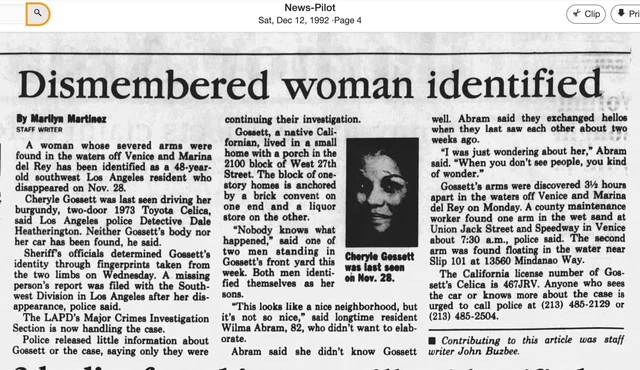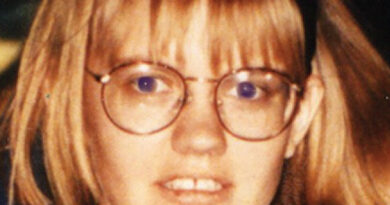Cheryle Gossett Body Parts Washed Up On The Beach Shore in Los Angeles California
The death of Cheryle Gossett in late 1992 in Los Angeles remains one of the most baffling and unresolved mysteries in Southern California homicide history. The case became notorious not for a sprawling crime scene or a dramatic chase, but for the eerie and fragmentary nature of its discovery: two severed arms, found days apart in separate coastal locations, identified by fingerprints, with the rest of her body never recovered. That limited physical evidence created a void investigators struggled to fill—no clear motive, no firm timeline of death, no crime scene to reconstruct, and no suspect ever publicly charged. The case endures as a stark reminder of the limits of forensic closure when key pieces are missing and the way a person’s identity can arrive at investigators not through their whole story but in isolated fragments.
Who Cheryle Gossett Was and Her Last Known Movements
Cheryle Gossett was a 48-year-old woman living in Southwest Los Angeles. In the days leading up to her disappearance, she was described by acquaintances as a person with obligations—she had gone out on November 28, 1992, to run errands and care for her elderly mother. She was driving her burgundy 1973 Toyota Celica, which became a focal point of investigative outreach after the grim discovery of human remains. Gossett had been reported missing when she failed to return, and concern mounted as days passed without contact or sightings.
Her identity, when it arrived to detectives, came in a disorienting and incomplete form: two severed arms. There was no immediate information about any struggle, no recovered vehicle in a crime scene littered with clues—only the dismembered limbs that appeared in the ocean, setting off a complex web of jurisdictional, forensic, and procedural challenges.
The Discovery: Floating Evidence, Separate Jurisdictions
In early December 1992, county workers patrolling the Los Angeles coastline noticed human remains in two disparate locations. One severed arm was found floating near Venice Beach and another shortly thereafter near Marina del Rey. Initially, the separate discoveries and the fact that they appeared in different jurisdictions—Venice falling under Los Angeles police purview and Marina del Rey initially investigated by the county sheriff’s division—created confusion. Each agency began its own inquiry, unaware at first that both limbs belonged to the same individual.
The arms had been in the water for less than 24 hours, according to forensic analysis, a critical detail that enabled fingerprints to be retrieved. That window of relative freshness became the linchpin for identification. Fingerprint comparisons, facilitated by the fact that Gossett’s prints were already on record due to prior law enforcement encounters, confirmed the identity of the dismembered limbs as belonging to Cheryle Gossett. Upon realizing both arms came from the same person, the LAPD’s Major Crimes Investigation Section absorbed the investigation, centralizing the fragmented efforts into a unified homicide inquiry.
Forensic and Investigative Challenges
What made the case so confounding was the extreme paucity of context. Investigators had two arms—no torso, no head, no identifiable crime scene, no known location of dismemberment. They lacked fundamental forensic anchors: without the rest of the body, precise determination of time of death, cause beyond dismemberment, or any manner of linking the remains to a location of attack was dramatically hindered. The absence of additional remains or witness reports intensified the mystery. Detectives, pathologists, and case agents were left grasping at disparate threads without a loom on which to weave them into a coherent narrative.
The questions multiplied. How had the arms entered the ocean? Had Gossett been killed elsewhere and dismembered deliberately with the parts dumped at sea? Or had her body entered the water intact and later separated through unknown processes—natural drift, scavenger activity, or human intervention? Investigators analyzed tidal charts, ocean currents, and weather patterns in an effort to retroactively model potential movement and origin points. They also issued alerts statewide for her missing vehicle, attempting to reconstruct her last known whereabouts through interviews with friends, family, and acquaintances who could shed light on her routines and any deviations in the days prior to her disappearance.
Theories were speculative; without additional physical evidence, they remained on tenuous footing. The lack of a known suspect, the absence of any confession, and the inability to recover more of her remains meant that every avenue of investigation had to be pursued with the expectation that the next lead might be the one to break the case, and yet none did.
Jurisdictional Coordination and the Weight of Silence
The early confusion between agencies underscored the challenges of homicide investigations that cross administrative boundaries. Initially, separate investigative tracks risked duplicating effort or missing linkages; the eventual consolidation into a single Major Crimes-led inquiry was critical, but valuable time and potential early leads existed in the opaque initial days. Investigators had to synchronize witness canvassing, forensic testing, and evidence preservation across a case that started as two isolated discoveries. Even after identification, the absence of further remains or corroborating physical traces conspired to keep the case persistently murky.
Compounding this was the silence around any suspect profile. Unlike cases where a person of interest emerges through consistent leads or a known adversarial relationship, Gossett’s case offered no publicly disclosed suspect, no behavioral pattern of a likely attacker, and no known conflict or documented threat prior to her disappearance. That lack of a known “who” outside the victim herself meant the investigation was a wide-ranging search for essentially any deviation from the ordinary in her last days—a needle hunt in a haystack with only a few fibers to guide the metal detector.
Public Appeal and the Hope for a Break
Even with the limited information, authorities went public with appeals, broadcasting the unusual circumstances in hope that someone might recall seeing Gossett’s car, witnessing suspicious activity, or knowing something small that, when placed against the broader puzzle, might yield a new direction. The state alert for her Toyota Celica demonstrated an early recognition that vehicles often outlive the immediate timeline of violence and could offer a trail: a parking spot, a mechanic’s interaction, a surveillance sighting, or a sighting by a passerby.
Investigators continued to follow every thread—questioning acquaintances to build a behavioral baseline, combing through the places she frequented, and evaluating whether any person she had interacted with had sudden changes in behavior after her disappearance. They also maintained hope for the recovery of additional remains; the presence of only two limbs held out the possibility, however slim with time, that other parts might surface or be located through renewed searches.
The Psychological and Emotional Aftermath
The manner in which Cheryle Gossett’s identity re-entered the world—through detached limbs—had an impact beyond the technical investigative difficulties. For her family and for the community, there was the extra layer of trauma that the knowledge of her death arrived without closure, without a public narrative explaining motive, assailant, or context. This kind of unresolved, partially revealed tragedy causes a particular kind of lingering pain: the human need for story, explanation, and justice was stymied by the fragmentation of evidence.
For the detectives and forensic teams, the case became a testament to professional frustration—the kind born not of lack of effort, but of systemic lack of data. They operated in the gray space between hope and resignation, periodically revisiting the case in cold case reviews, looking for what might have been overlooked, reconsidering witness statements in new light, and sometimes applying emerging forensic methods in later years in the hope that a technological advance might spark a breakthrough.
The Case’s Legacy: Unsolved but Not Forgotten
Decades later, the murder of Cheryle Gossett remains officially unsolved. Her case is archived among Los Angeles’ unsolved homicides, and it represents an archetype of mysteries that persist not because of elaborate cover-ups or complex conspiracies—but because of absence: absence of the body, of a killer in custody, of clear motive, and of a definitive narrative. It occupies a space in public consciousness that mingles fascination, sorrow, and the gnawing discomfort of cognitive incompleteness.
Her story has been revisited in retrospectives, true crime examinations, and investigative discussions as a cautionary example of how vital every piece of evidence is in building an investigation. It also underscores the reliance of forensic and police work on reconstructive context; when that context is missing, even competent institutions are dramatically handicapped.
The case also lives in the quiet persistence of those who refuse to let the details fade entirely—through cold case file reviews, through public memory in forums that catalog unsolved crimes, and in the internal files of law enforcement that occasionally surface in limited public summaries or discussions. The hope, even decades on, is that a forgotten witness, a re-examined clue, or a technological leap will provide the fragment needed to finally complete the picture and give Gossett’s family the answers they have long been denied.
Conclusion
The death of Cheryle Gossett in December 1992, marked by the discovery of her severed arms washing ashore separately in Los Angeles County waters, remains a haunting absence rather than a concluded story. The investigation was dogged and thorough within the constraints imposed by fragmentary evidence, yet the fundamental questions—who killed her, why, and what happened to the rest of her—remain unanswered. Her case persists as both an emblem of investigative limitation and a silent plea for eventual resolution. In the gap between what is known and what is missing, her name endures, carried by those who remember and those who continue to search.
Discover more from City Towner
Subscribe to get the latest posts sent to your email.




